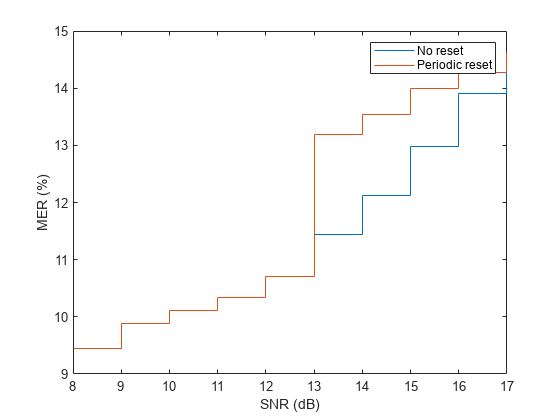comm.MER
Measure modulation error ratio of received signal
Description
The comm.MER
System object™ computes a form of signal-to-noise ratio (SNR) measurement that you can use to
assess the ability of a receiver to accurately demodulate a signal. Specifically, it returns
the modulation error ratio (MER), minimum MER, and percentile MER for a received signal. You
use the MER measurements to determine system performance in communications applications. For
example, to determine compliance with applicable DVB-T system radio transmission standards
conformance testing requires accurate MER measurements.
To measure the MER of a received signal:
Create the
comm.MERobject and set its properties.Call the object with arguments, as if it were a function.
To learn more about how System objects work, see What Are System Objects?
Creation
Description
mer1 = comm.MER
mer1 = comm.MER(Name=Value)comm.MER(ReferenceSignalSource="Estimated from reference
constellation") configures the object to measure the MER of a received signal
relative to a reference constellation.
Properties
Usage
Syntax
Description
merdb = mer1(refSym,rxSym)rxSym relative to reference signal
refSym over the measurement interval specified in the MeasurementIntervalSource and MeasurementInterval
properties.
[
also returns the minimum percentage MER over the configured measurement interval.merdb,minMER] = mer1(refSym,rxSym)
To use this syntax, set the MinimumMEROutputPort
property to true.
[___,
also returns the value below which X% of MER measurements fall using
all input frames since the last reset, regardless of measurement interval configuration.
Set the value of X in the pMER] = mer1(refSym,rxSym)XPercentileValue property. For
example, if you set the XPercentileValue to 95,
then 95% of all MER measurements since the last reset fall below the value of
pMER.
To use this syntax, set the XPercentileMEROutputPort property to true.
[___,
also returns the number of symbols used to measure MER. To use this syntax, set the
pMER,numSym] = mer1(refSym,rxSym)XPercentileMEROutputPort and SymbolCountOutputPort to
true.
[___] = mer1( measures the
MER of the received signal relative to the reference signal specified in the rxSym)ReferenceConstellation
property. You can use this syntax with any previous output argument combination.
To use this syntax, set the ReferenceSignalSource
property to "Estimated from reference constellation".
Input Arguments
Output Arguments
Object Functions
To use an object function, specify the
System object as the first input argument. For
example, to release system resources of a System object named obj, use
this syntax:
release(obj)
Examples
Algorithms
MER is a measure of the SNR in a modulated signal calculated in dB. The MER over a burst containing N symbols is
where:
ek = .
Ik represents the in-phase component of the kth symbol in the burst.
Qk represents the quadrature phase component of the kth symbol in the burst.
Ik and Qk represent ideal reference values.
and represent received symbols.
N represents the number of symbols in the burst.
The MER for the kth symbol is
The minimum MER represents the minimum MER value in a burst, or
The algorithm computes the X-percentile MER by creating a histogram of all the incoming MERk values. The output provides the MER value above which X% of the MER values fall.
References
[1] ESTI TR 101 290. "Digital Video Broadcasting (DVB): Measurement guidelines for DVB systems." June 2020.
Extended Capabilities
Version History
Introduced in R2012a
